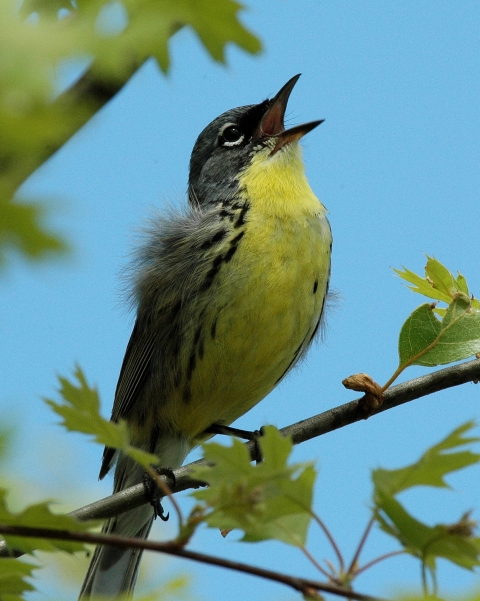About Us
Kirtland’s Warbler Wildlife Management Area was established in 1980 in response to the need for more land dedicated to the recovery of the Kirtland’s warbler, which was on the endangered species list from 1967 to 2019. The management area contains 125 separate tracts of land totaling 6,684 acres located throughout eight counties in the northern Lower Peninsula of Michigan.
The Kirtland’s warbler is a small, neotropical migrant that summers in Michigan, and to a limited extent Wisconsin and Ontario, and winters in the Bahamas. By the mid-twentieth century, the bird was in trouble. Wildfire, a natural ecological process vital to producing its habitat, had been reduced in frequency and extent, severely reducing the bird’s population.
A survey of Kirtland’s warbler in 1951 found 432 singing male birds. By the 1970s, fewer than 200 singing males were surveyed on an annual basis. In 1967, the species was placed on the Federal Endangered Species List. Due to management efforts, the bird’s population began to recover in the 1990s. In 2008, the total estimated population of singing males in Michigan was 1,791. Through cooperative efforts among conservation partners, the Kirtland’s warbler population has grown and was estimated to be more than 2,300 pairs in 2019 - more than double the number outlined in the recovery plan. On Nov. 8, 2019 the Kirtland’s warbler was officially removed from the Endangered Species List. Today, the Kirtland’s warbler is monitored to ensure its numbers remain strong.
The management area tracts are surrounded by Michigan state forests that are designated to be managed for the benefit of Kirtland's warblers. Although the bird has adapted to wildfire-regenerated jack pine, prescribed fire is not practical in most areas due to the explosive wildfire nature of jack pine and the existence of summer homes and other human developments in these areas. Homes are scattered all through the state forests and fire creates serious hazards to life and property. Because fire is not an acceptable means to regenerate most jack pine stands, timber sales, direct seeding and planting are often the only options to establish stands.
Our Mission
The mission of the National Wildlife Refuge System is to administer a national network of lands and waters for the conservation, management and, where appropriate, restoration of the fish, wildlife and plant resources and their habitats within the United States for the benefit of present and future generations of Americans.
Our Purpose
Every national wildlife refuge national wildlife refuge
A national wildlife refuge is typically a contiguous area of land and water managed by the U.S. Fish and Wildlife Service for the conservation and, where appropriate, restoration of fish, wildlife and plant resources and their habitats for the benefit of present and future generations of Americans.
Learn more about national wildlife refuge was created for a special purpose. Some were created to protect migratory birds, others to protect threatened or endangered species, while others fulfill another special purpose. All activities allowed on refuges must be evaluated to make sure each activity will not conflict with the reason the refuge was founded.
Kirtland’s Warbler Wildlife Management Area is part of the National Wildlife Refuge System and was established for the conservation of an endangered species, the Kirtland’s warbler. After reaching the endangered species plan’s recovery goals the bird was listed as recovered in 2019. Kirtland’s warblers are picky tenants. They need specialized habitats and depend on young jack pine forests, so proper land management is vital to their continued success. The U.S. Fish and Wildlife Service and its partners are committed to managing the area in a way that will continually benefit the bird.
Our History
1967 - The Kirtland’s warbler is added to the Federal Endangered Species List.
1980 - The Kirtland’s Warbler Wildlife Management Area is established to help meet the needs of the bird and help it recover.
Nov. 8, 2019 - The Kirtland’s warbler is delisted or removed from the Federal Endangered Species List. It is now considered recovered; however lands will still need to be managed by taking the bird’s very particular habitat needs into consideration. The bird is being monitored closely to ensure its population numbers remain stable or increase.
Other Facilities in this Complex
Kirtland’s Warbler Wildlife Management Area is part of a complex of refuges. Staff at Seney National Wildlife Refuge manage the refuges in northern Michigan including Harbor Island and Huron National Wildlife Refuges. Staff share management of the Michigan Islands National Wildlife Refuge with Shiawassee National Wildlife Refuge.




